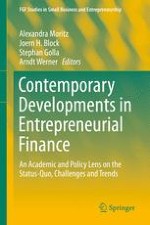2020 | OriginalPaper | Buchkapitel
Democratising Entrepreneurial Finance: The Impact of Crowdfunding and Initial Coin Offerings (ICOs)
verfasst von : Erik Ackermann, Carolin Bock, Robin Bürger
Erschienen in: Contemporary Developments in Entrepreneurial Finance
Verlag: Springer International Publishing
Aktivieren Sie unsere intelligente Suche, um passende Fachinhalte oder Patente zu finden.
Wählen Sie Textabschnitte aus um mit Künstlicher Intelligenz passenden Patente zu finden. powered by
Markieren Sie Textabschnitte, um KI-gestützt weitere passende Inhalte zu finden. powered by
